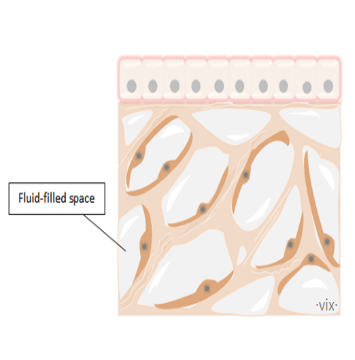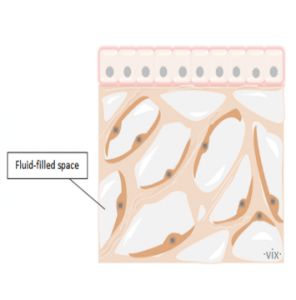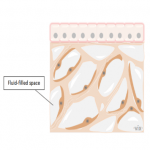
Interstitium, as a fluid-filled space with cells and collagen bundles. (Based on the illustration by J. Gregory). Illustrator: Vix Maria ©biologyonline.com
Table of Contents
Scientists found, apparently by accident, a new biological organ and they want it called “interstitium“. The discovery was published in Scientific Reports and authored by Dr. Petros Constantinos Benias and others.1 They described this new biological “organ” as a set of fluid-filled, interconnected spaces supported by collagen and elastin connective tissue proteins located just beneath the skin surface. It might be one of the largest organs of the human body. This may lead to a further understanding of cell movements, particularly during inflammation, tissue repair, and cancer metastasis.
Interstitium – the phantom organ?
Hitherto, the interstitium was regarded as a type of connective tissue (i.e. dense connective tissue) that lines various bodily organs, such as those of the digestive tract, the lungs, and the urinary system.2 Failure to perceive the interstitium as a biological organ early on was attributed to the way the tissue samples were customarily prepared. Microscopic examination of tissue samples would have to be carried out through tissue slides following fixation and staining procedures. The end result is the loss of structural integrity of the tissue as much fluid would have been drained after these steps. Consequently, it circumscribed histologists from perceiving the interstitium in vivo. Anyone would fail to recognize it as interconnected conduits where fluid moves by applying classic histological techniques.
Interstitium – a newfound organ
By chance, the interstitium was found to exist using confocal laser endomicroscopy. A group of scientists inserted a thin camera into the bile duct tissue in search for signs of cancer. The unrecognizable tissue images they took did not match any anatomical features presently identified. Consequently, they proposed that the newly found structure be called interstitium. They reported that this seemingly new biological organ had a depth of 60 to 70 micrometers, supported by a meshwork of collagen, and filled with lymph that drains into the lymph nodes. They surmised that the interstitium was a source of lymph and therefore it might have played a crucial role in inflammation. Further, they postulated that it might also have helped cancer cells to reach the lymph nodes and eventually helped them spread to other organs. They also inferred that the cells in the interstitium might be responsible, in part, for the wrinkling of the skin, the stiffening of limbs, and certain inflammatory diseases.1
Interstitium – a biological organ?
By definition, a biological organ is a group of tissues that perform a specific function or group of functions. The interstitium as a biological organ is doubted by some skeptics. Jennifer Munson, a biomedical engineer at Virginia Tech, believes in the existence of the interstitium but is skeptical about its status as a biological organ.2 Further studies are indispensable to define its structure and function as well as to establish its relevance in the pathological mechanisms of certain diseases.
Gaining an insight into the structural form and function of the human body is certainly awe-inspiring. In these days that technology is continually taking a major leap, a step back still proves to be essential. It helps reaffirm the veracity of what was once reckoned as factual. The interstitium – whether it gains the status of being a biological organ or not – is a promising avenue towards a better understanding of human anatomy and physiology.
— Written by Maria Victoria Gonzaga
References
1Benias, P. C., Wells, R. G., Sackey-Aboagye, B., Klavan, H., Reidy, J., Buonocore, D., Miranda, M., Kornacki, S., and Wayne, M. (2018). “Structure and Distribution of an Unrecognized Interstitium in Human Tissues”. Scientific Reports. 8 (1). doi:10.1038/s41598-018-23062-6
2Gibbens, S. (2018). New Human ‘Organ’ Was Hiding in Plain Sight. Retrieved from [https://news.nationalgeographic.com/2018/03/interstitium-fluid-cells-organ-found-cancer-spd/]
3Gregory, J. (illustrator). [http://www.jillkgregory.com]

